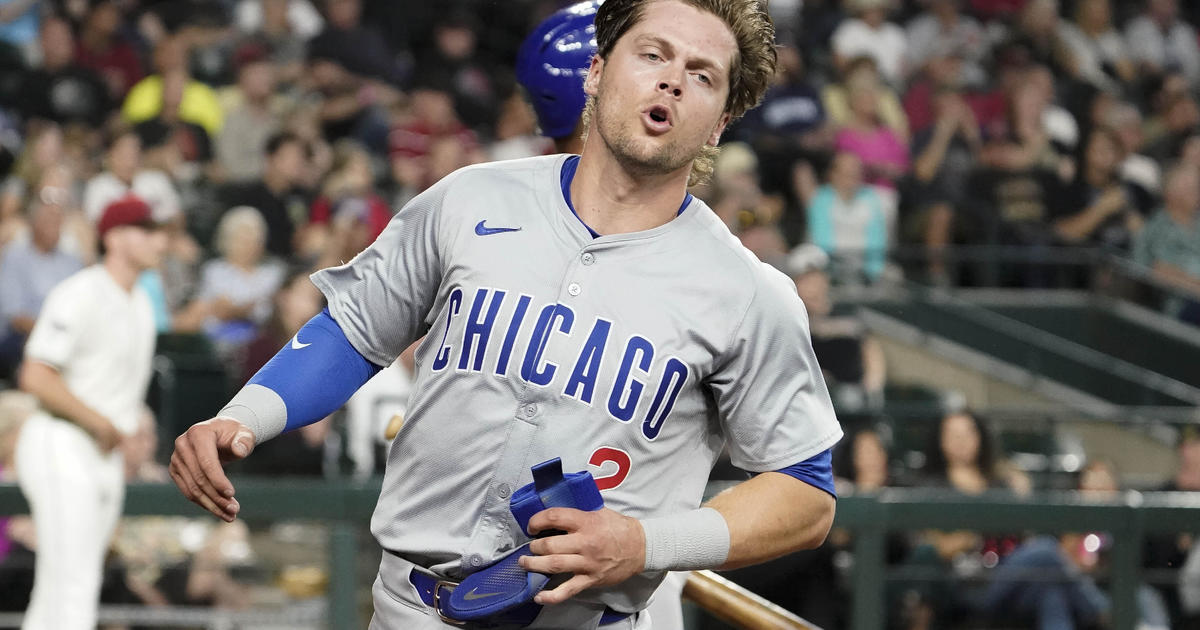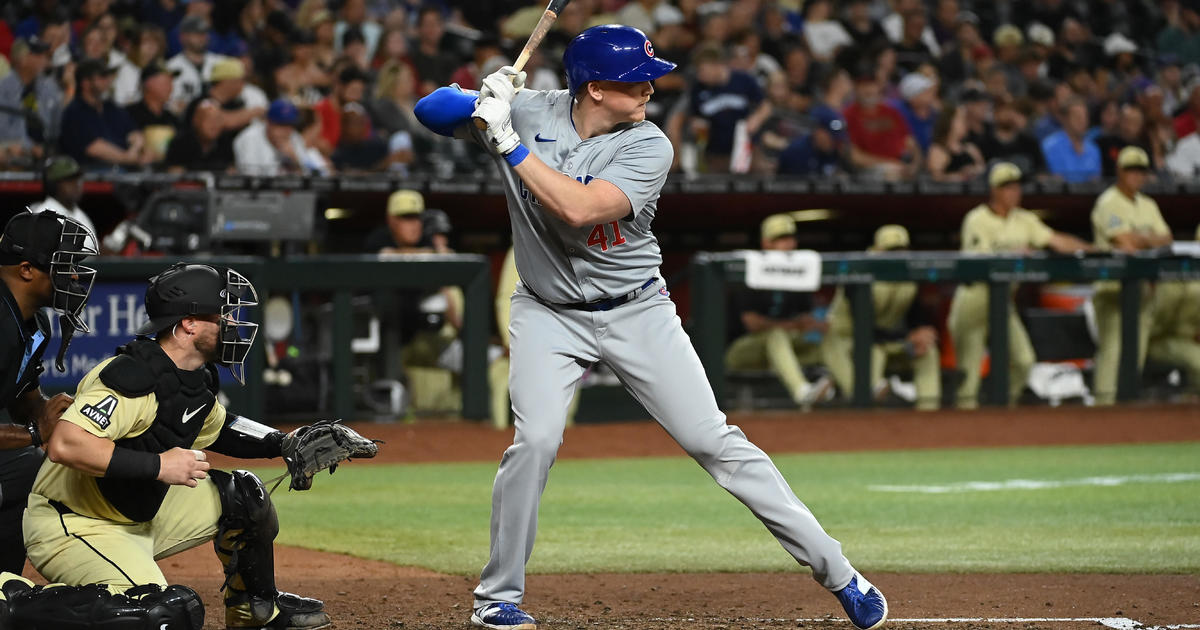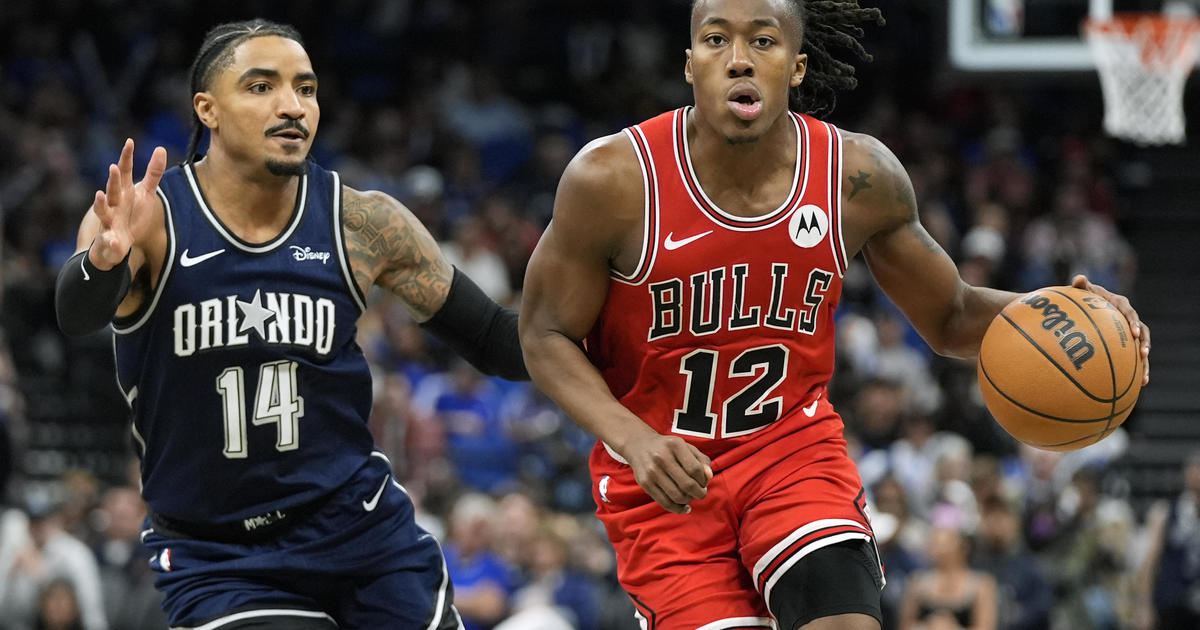Hoge: Inside The Headset
By Adam Hoge-
CHICAGO (CBS) — Josh McCown stood there at the 19 yard line, his cleats sinking into the mixture of Kentucky Bluegrass and mud. Glancing left and then looking right, he saw exactly what he wanted.
The 34-year old quarterback quickly took three steps forward, nearly walking into the A-gap between center Roberto Garza and left guard Matt Slauson. He yelled first to the left, where tight end Martellus Bennett added extra protection next to left tackle Jermon Bushrod. Then he yelled right.
Immediately aware of what his quarterback was doing, Forte — originally aligned to the right of McCown's shotgun positioning — switched to the left. McCown then backpedaled to his original spot at the 19, exactly five yards behind the sloppy football that was positioned underneath his center.
With the play clock down to six seconds, the quarterback called for the snap and immediately faked a handoff to Forte, who was now working left to right. Keeping his eyes to the left until the very last moment, McCown then dumped the ball off to the right, where his running back was waiting.
The screen didn't work perfectly. The wet, clumpy field negated the aggressive rush the Bears were expecting from the Baltimore Ravens. Forte had to improvise, cutting inside the block of right guard Kyle Long before forcing cornerback Corey Graham to slip and fall on his back at the 10 yard line. At that point, Forte needed one more block and Slauson was waiting near the goal line to get just enough of safety James Ihedigbo. A desperate effort from defensive end Chris Canty nearly took Forte down from behind just before he reached the end zone, but the running back slipped the Ravens' final hope and gave the Bears the lead with 10:42 left in the fourth quarter.
The play was a staple of Marc Trestman's brief tenure as Bears head coach, his reign now into its 11th month.
The man dubbed the "Quarterback Whisperer" didn't invent the screen pass or anything, but he is responsible for the offensive evolution that has occurred in Chicago since general manager Phil Emery decided to make a head coaching change last New Year's Eve.
It's not that Trestman has rewritten the NFL playbook, but he has greatly improved the offensive preparation inside Halas Hall and fixed the communication breakdowns that held back a unit that still included the talents of Jay Cutler, Brandon Marshall and Matt Forte a year ago.
Everything runs smoother on game day now. Confusion at the line of scrimmage? Rare. Pre-snap penalties? The Bears only had two in the first nine weeks. Botched plays? The Simpsons could count them on one hand.
It helps when your head coach is in charge of the offense. Trestman calls the plays from the field, with no need for a middle man. If the quarterback has a message for his play caller, he doesn't need to yell at an assistant on the sideline to relay it up to the coaches' booth. And it doesn't hurt that offensive coordinator Aaron Kromer is on the field as well.
The genesis of what Trestman calls on Sundays — much of which is packaged for the quarterback to improvise at the line of scrimmage — started way back in April when the head coach gathered his team at Halas Hall for their first mini-camp together. His players were given scripts three to four days in advance and were expected to know about 100 plays by the first practice. Another 85 plays or so were thrown at them by the second practice and by the third practice, they had to know 40 plays as they were called out, without being provided a script ahead of time.
If the head coach is going to be detailed, the players need to be detailed too.
That was just the beginning of it. What started as a hectic free-for-all inside the Walter Payton Center in April —with minimal strategy and only teammates across the line of scrimmage — was eventually boiled down into game plans by September, each one unique to the other, with specific intricacies built in to defeat that week's opponent.
The go-ahead screen pass to Forte last Sunday was one of those intricacies. The coaching staff saw the Cincinnati Bengals run a similar play against the Ravens the week before and knew it would work if the quarterback could diagnose the same front and coverage at the line of scrimmage.
McCown originally went to the line with a different call, but he got the look he wanted and changed the play.
"We decided we wanted to run the screen because we wanted to run it only against a certain coverage and we got that coverage, fortunately," Trestman said. "If we wouldn't have gotten it, we would have run the first play in the package."
Thus, Trestman's system demands a lot from the quarterback both on and off the field. The studying during the week is intense and the decision-making process on the field is pressure-packed.
But, when run correctly, it gives the Bears at least one favorable matchup on the field and increases the probability of that play being successful, which is exactly what the franchise's new analytical approach is trying to accomplish.
The pre-snap sequence that led to Forte's go-ahead touchdown against the Ravens never would have happened two years ago. It never would have happened because the quarterback couldn't change the play at the line scrimmage when Mike Martz was the offensive coordinator.
Those days seem ancient in the NFL now. In fact, they were ancient when the Bears were still living in them. And that's why Marc Trestman was called upon.
-----------------------------------------
21.
McCown hears the number in his headset and echoes it to his teammates on the field. "21" means two backs and one tight end. Add five linemen and a quarterback to the equation and that leaves room for two wide receivers.
Based on a simple number, everyone understands if they are supposed to be on the field or off it.
Trestman already knows what play he is calling. Each play on the call sheet has a personnel grouping listed next to it. The head coach pauses to make sure the right personnel has been relayed and then he pushes down on the headset button hanging off his right hip to communicate the actual play call.
Red Right Y Short 22 Texas.
No, that's not an actual play from Trestman's playbook, but it is what one could sound like.
Each call starts with the formation. "Red" is short for "regular" personnel, which is two backs and one tight end. "Right" refers the formation strength, which is the side the tight end (Y-receiver) lines up. The next part of the play call indicates any kind of motion or movement. "Y Short" calls for short motion by the tight end. Next is the protection scheme, which is typically built into the play number, in this case "22". The final part is the concept of the play being run. "Texas" calls for the Y-receiver (tight end) to run a curl over the middle and the X-receiver to run a 9-route or a post against Cover-3. Note the code word "Texas" starts with a "TE" and an "X".
"As Marc's saying it, I'm just trying to visualize it and then I step in there and repeat it to the guys," McCown said. "Sometimes there's little tidbits here and there of help nuances to remember to do this, remember to do that. But for more the most part, it's just call the play, then give them the snap count and then break the huddle."
That's just the start of it.
Once lined up, McCown immediately surveys the field to identify blocking schemes and coverages. You'll often see the quarterback point at guys or call out the "Mike" (middle linebacker) because, according to McCown, "that's where all the structure of a lot of the plays are based off of."
Essentially, he's making sure everyone is blocking the right people, for both runs and passes.
And if it's a packaged play, this is when the quarterback makes the decision to check to something else, which is identified by a mechanism he'll call out.
Of course, things don't always go as planned.
-----------------------------------------
Teams are at the mercy of the NFL when it comes to the communication system working properly. It's all set up ahead of time and the coaches are at the end of the line. They're just handed the headset right before kickoff and trust that it works.
That's not always the case though. Trestman said there have been three or four instances this year where they lost communication.
Of course, sometimes it's their own fault. The coach-to-quarterback and coach-to-defensive signal caller headsets automatically shut off with 15 seconds left on the play clock, which means everything must be communicated quickly. A league-appointed operator is in charge of shutting off communication at the 15-second mark or when the ball is snapped, whichever occurs first. Communication is then restored once the game official has signaled the play is dead.
So what happens if a play call is not communicated clearly?
For the Bears, it used to mean a lot of timeouts. Not so much now.
The backup quarterback usually stands next to Trestman and is in charge of making sure the quarterback on the field heard the play call correctly. Trestman starts planning ahead to the next play as soon as he's done communicating over the headset, so it's up to the backup to let him know if he needs to repeat the play again. Of course, he can only do so if there's more than 15 seconds left on the play clock. If there's not, the Bears go to Plan B.
McCown said if you do your homework, you can often piece together the rest of a play call if it gets cut off by the clock.
"Sometimes you get half of it and throughout the week you've studied and you know how to piece together the rest of the play call because you know what it's supposed to be by what you've heard already," he said.
The play calls are verbalized in meeting rooms and then again on the practice field as the game plan is installed each week.
But if all else fails, the Bears have plays set aside that the quarterback can go to as a last resort. They are universal to the personnel, meaning they can be run no matter who is on the field.
"It's kind of a universal play that we can get executed and then they always hold the trump card on the sideline. If it's a situation that they don't want to do that — they want to make sure we have the right play called — they'll just bang a timeout and then we'll talk about it and make sure we have everything fixed," McCown said.
Trestman said twice this season they've called timeout in those "crucial situations."
The technical side of the communications is not something the players and coaches have time to worry about. It's an impressive operation and the NFL invests a lot of time and money into it to make sure everything works properly. On game days, any media organization that requires the use of any kind of wireless signal (other than the internet or cell phone) must register it with an on-site coordinator. The frequencies must all match up to avoid interference.
And just to make sure teams don't hack into each others' headsets, "the communication is encrypted, and the encryption scheme accommodates approximately one trillion possible key combinations with each system to provide a security service to assure private communication," according to a league spokesperson.
Essentially, most coaches are clueless when it comes to why it all works. They have enough to worry about and just trust that it's secure.
"I don't worry about any of the other stuff," Bears defensive coordinator Mel Tucker said.
-----------------------------------------
Regular Under 2 Smash.
The communication on the defensive headsets can be even more chaotic. The offense is in control, with the defense reacting to the substitutions made on the other sideline.
Mel Tucker spent the first seven weeks of the season in the coaches' box upstairs, but after injuries forced two rookie linebackers onto the field, he made the decision after the Bears' bye week to move to the sideline in an effort to improve communication.
It's been a hectic year for the Bears and their defensive play calls. With Brian Urlacher retiring in the offseason, weak side linebacker Lance Briggs volunteered to take over the signal calling, but he admitted in training camp he wasn't exactly comfortable with the job. Rookie middle linebacker Jon Bostic handled the signal calling for the second-team defense in the preseason, so when Briggs went down with a shoulder injury in Week 7, Bostic inherited the gig during a crazy second half in which the Bears allowed 21 points to the Redskins, including an 80-yard touchdown drive in the final three minutes that resulted in a 45-41 loss.
During the ensuing bye week, Tucker made two big decisions. First, he decided veteran strong side linebacker James Anderson should handle the defensive signal calling instead of Bostic. Second, with raw rookie Khaseem Greene getting thrown into the fire in Briggs' place, the defensive coordinator decided he was better suited on the sideline where he could talk to his defense face-to-face.
"This is my 17th year coaching and I've spent significant time on the field during games and also I've spent a lot of time in the box, so I've been both places," Tucker said. "Being on the field on game day is very similar to being on the field in practice."
The players have welcomed the move. Because of the way the headsets are set up, communication to the on-field helmet earpiece can only come from the sideline, not the coaches' box upstairs. Thus, when Tucker was upstairs, he had to communicate the call to linebackers coach Tim Tibesar on the sideline first and Tibesar would then relay it to the signal-caller on the field.
"It makes communication easier. It makes everything move a little bit faster," Anderson said.
And speed is everything when it comes to getting a play called on defense. The coach-to-linebacker headset turns off with 15 seconds left on the play clock too, but the defense can't make its first move until it recognizes the opposing personnel.
Thus, the trade off for Tucker moving downstairs is that he depends on his assistants upstairs more. Assistant defensive line coach Mike Sinclair switched places with Tucker and moved to the coaches box alongside defensive quality control coach Chris Harris, who was already positioned up there. It's easier to diagnose breakdowns in the defense from up above and it's also easier to identify the down and distance, as well as offensive substitutions.
For any defensive coordinator, that's where a play call starts.
"First thing we got to get is the down and distance. We get that from the box," Tucker said. "Then we try to decipher the offensive personnel package — how many receivers they have in the game, backs, tight ends — and get the field position. That comes from the box."
At that point, Tucker makes his call. He presses the button and gives it to Anderson.
Regular Under 2 Smash.
Again, this is not necessarily a play straight from the Bears' defensive playbook, but it is a common call for a zone-based defense. "Regular" refers to regular personnel — three linebackers, four defensive backs. The next part of the call is the front, so this particular play calls for an "Under" front. "2" calls for a Cover-2 (two deep safeties) look from the secondary. The final part of the call is usually a code word that calls for either a blitz, stunt or both. In this case, "Smash" calls for a Sam (strong side linebacker) and Mike (middle linebacker) blitz. Notice that the code word starts with an "S" for Sam and "M" for Mike.
"I keep my hand on the button, make sure (Anderson's) got it and then he relays that call to the rest of the players and then they echo the call and then they play the snap," Tucker said.
But there's more to it then that.
At this point, the defense still doesn't know what formation the offense is in. Anderson has to diagnose the formation and make checks and adjustments at the line of scrimmage. With the headset usually shut off at this point, this is up to him.
Typically the checks let the rest of the defense know if a particular blitz or stunt is still on. Urlacher would often make a "raise the roof" motion with his arms. This was done to let the secondary know if the call was still on. Another common check at the line is an adjustment of where the nose tackle is lined up. This is all determined by how the offensive personnel lines up.
Of course, the opposing offense is trying to get the defense to tip its hand with pre-snap movement. And many times it works.
"Certain calls, they can figure you out and there's nothing you can do about it," Anderson said. "Like if you're in a man coverage and they quarter run, there's just nothing you can do about it. But still sometimes you can show one thing and play something else."
And, just like the offense, the communication doesn't always work perfectly. The calls on defense are typically simpler, so that helps get everything communicated faster, but there are still situations where the call comes in late or the call doesn't match the offensive personnel on the field. That is the most common pre-snap breakdown for a defense. The rules are set up to make it fair for the defense to get the right players on the field — if the offense chooses to sub, the referees will stand over the ball until the defense makes its substitutions — but that doesn't always happen as planned. If a defense gets caught in base when they should be in nickel, you might end up with a linebacker covering a wide receiver, which qualifies as one of those mismatches Marc Trestman is constantly trying to create on offense.
And thus, we've come full circle.
-----------------------------------------
There seems to be a misconception that because Trestman is in charge of the offense, Aaron Kromer is not really the Bears' offensive coordinator. But while Kromer may not have veto power, he still plays a large role in what Trestman ultimately calls.
"The process of the play calling always starts before the series begins," Kromer said. "So as an offense, we'll be on the headset together, talking through some ideas that each of us have and where we want to go on the next drive. So we'll come up with four or five run plays that we like and four or five pass plays that we like."
Because Trestman is the head coach and still has to manage game decisions when the Bears' defense is on the field, he relies on Kromer heavily in between offensive series. The conversations on the sideline will also include things like whether or not they should run more on first down or pass more on first down. The result of those conversations produce the plan for the next drive.
"Once the drive starts, then Marc has the communicator with the quarterback and he's in his headset," Kromer said. "We already have it planned out and we called it accordingly. And any adjustments, obviously, Marc being the head coach, makes those adjustments."
The plays are listed in the progression the Bears hope plays out. In other words, if the plays are all successful, they'll get called in order. But if they're not successful, that's when Trestman will make the needed adjustments. Not all the plays fit all the situations.
Kromer can give his input in between plays too.
"Each play we're communicating and I may say, 'You know, go to this run' and he might start calling a pass," Kromer said. "Then I'm just quiet and he calls the pass and then he'll say, 'All right let's get that on the next play,' and we'll call the run on the next play. So it's constant communication and it's a group effort that has worked out well."
Kromer is also in control of what runs are called. Trestman ultimately decides whether to pass or run, but if he goes with a run, he trusts the run that Kromer gives him.
And "trust" might be the most important thing Trestman has brought to the Bears' offense this season. In recent years, trust has been lacking, particularly between the quarterback and play caller. This year, not only do the quarterbacks — specifically Jay Cutler — trust what Trestman is calling, but Trestman also trusts his quarterbacks to make the right decisions at the line of scrimmage.
Such trust has to be earned long before the play caller presses that button and communicates the play to his quarterback, but that's exactly what has happened in Chicago over the last 11 months. The building blocks of that trust may start behind the closed doors of Halas Hall, but the results are not hidden.
Not only were the results evident on the successful screen pass to Matt Forte against the Ravens, but it was even more evident about 45 minutes later in overtime when Trestman called on Josh McCown to make the biggest throw of the game — maybe even the season.
As the call came in, McCown knew the first look in his progression was a slant-and-go to Brandon Marshall. He also knew the second look was a deep throw to tight end Martellus Bennett on a seam route — no easy feat with the unpredictable wind blowing at Soldier Field on a stormy day. Such a call fit the arm of Jay Cutler much better, but Trestman didn't care. He trusted his backup to make the throw.
McCown recognized the man coverage from cornerback Lardarius Webb on Bennett — one of those mismatches, no doubt. The throw to Marshall was not open, so McCown reached back and spiraled the football straight through the wind where Bennett had a step on Webb downfield. The throw couldn't have been much better. McCown put it in just the right spot with just the right timing, allowing Bennett to turn around, spot the football and catch it at the highest point, leaving Webb with no chance to make a play. For added measure, Bennett kept his footing and gained another 15 yards before finally getting dragged down from behind at the Ravens' 22 yard line.
It was a gain of 43 yards, allowing kicker Robbie Gould to hit the game-winning field goal three plays later.
It was also a play that probably wouldn't have worked a year ago, mainly because the Bears didn't have a tight end like Martellus Bennett to make such a grab, but also because the offense wasn't nearly as advanced. Such created mismatches were not as abundant.
"We caught them in a blitz," Trestman said. "I saw them in single safety. That's what we wanted."
A capable offense is all Bears executives and fans wanted.
And that's exactly what they got with Marc Trestman.
Adam Hoge covers the Bears for CBSChicago.com and is a frequent contributor to 670 The Score. Follow him on Twitter at @AdamHoge.
(Dan Durkin contributed to this story.)





